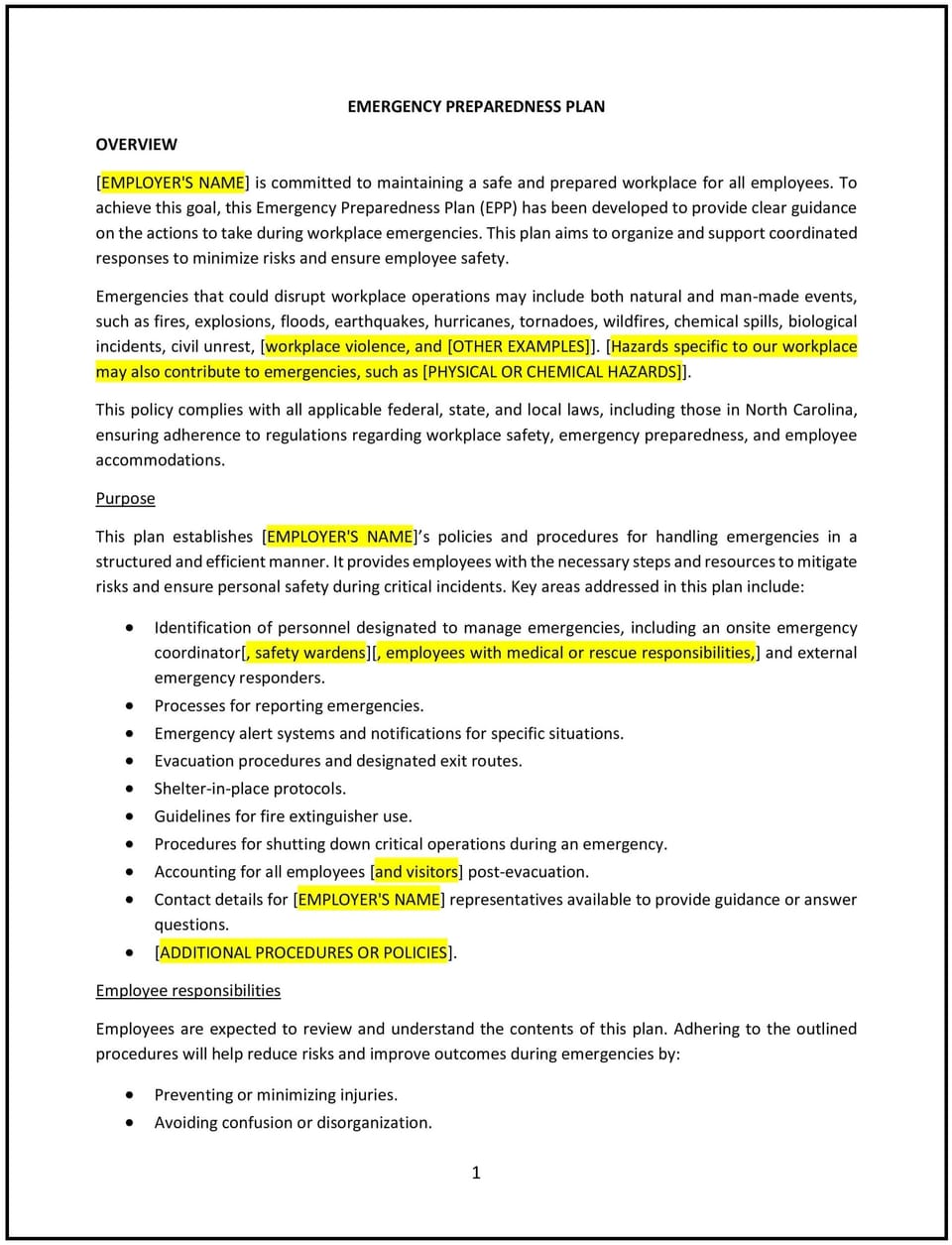Emergency preparedness plan (North Carolina): Free template

Emergency preparedness plan (North Carolina)
An emergency preparedness plan helps North Carolina businesses establish procedures for responding to various emergencies, such as natural disasters, fires, medical emergencies, or workplace accidents. This policy outlines the steps to take before, during, and after an emergency, including roles and responsibilities, evacuation procedures, communication protocols, and safety measures.
By adopting this plan, businesses can ensure the safety of employees, minimize damage to company property, and maintain business continuity during unexpected events.
How to use this emergency preparedness plan (North Carolina)
- Identify potential emergencies: Specify the types of emergencies the company may face, including natural disasters (e.g., hurricanes, floods), fires, medical emergencies, and other workplace incidents.
- Define employee roles: Assign specific roles and responsibilities to employees during emergencies, including evacuation coordinators, first aid responders, and emergency communication personnel.
- Establish evacuation procedures: Outline the procedures for evacuating the building in case of fire, gas leak, or other emergencies, including designated evacuation routes and assembly areas.
- Set up emergency communication: Define how employees will be notified of an emergency, how to communicate during an event, and how employees should report emergencies.
- Reflect North Carolina-specific considerations: Ensure the plan complies with state-specific emergency preparedness laws, including any local regulations on disaster response and safety protocols.
Benefits of using this emergency preparedness plan (North Carolina)
This policy provides several benefits for North Carolina businesses:
- Protects employees: The plan ensures employees’ safety during emergencies by providing clear instructions on what to do and where to go in case of a crisis.
- Reduces business disruption: A well-structured emergency preparedness plan minimizes downtime and helps the business resume normal operations as quickly as possible after an emergency.
- Enhances legal compliance: The plan helps the business comply with North Carolina’s workplace safety laws, as well as federal regulations such as OSHA requirements for emergency preparedness.
- Increases employee confidence: Employees will feel more secure knowing that the company has a well-defined plan in place to protect them in case of an emergency.
- Strengthens business reputation: Demonstrating preparedness enhances the company’s reputation as a responsible and safe employer, fostering trust among employees and clients.
Tips for using this emergency preparedness plan (North Carolina)
- Communicate the plan clearly: Ensure all employees understand the emergency preparedness plan, their roles, and the procedures to follow in case of an emergency.
- Conduct regular drills: Hold emergency drills, such as fire drills or evacuation drills, to ensure that employees are familiar with the plan and can respond quickly in an emergency.
- Review and update the plan regularly: The plan should be reviewed and updated annually to account for any changes in company operations, employee roles, or North Carolina regulations.
- Train employees: Provide training for employees on emergency response, first aid, and other critical safety measures.
Q: What types of emergencies does the plan cover?
The plan should cover a wide range of potential emergencies, including natural disasters (e.g., hurricanes, tornadoes), fires, medical emergencies, and other workplace accidents.
Q: How are employees notified of an emergency?
The plan should outline the methods for notifying employees, such as emergency alerts via phone, email, or loudspeakers, and provide instructions for immediate action.
Q: Who is responsible for implementing the emergency preparedness plan?
The company should designate an emergency response team, including specific individuals responsible for evacuations, first aid, and communication.
Q: How often should the emergency preparedness plan be reviewed?
The plan should be reviewed annually to ensure it remains up-to-date with any changes in company operations or North Carolina safety regulations.
Q: What happens if employees are unable to evacuate during an emergency?
The plan should outline procedures for employees who are unable to evacuate, including emergency shelter or safety measures that can be taken to protect them.
This article contains general legal information and does not contain legal advice. Cobrief is not a law firm or a substitute for an attorney or law firm. The law is complex and changes often. For legal advice, please ask a lawyer.


